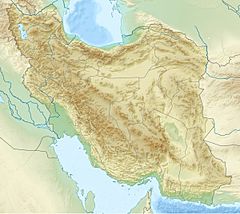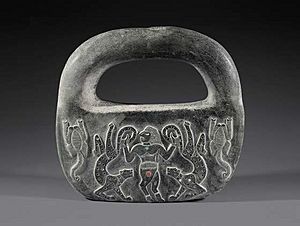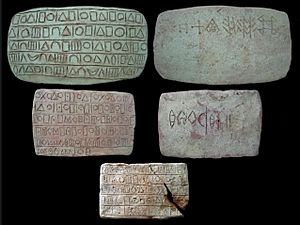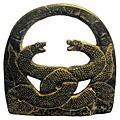Jiroft culture facts for kids
Quick facts for kids Jiroft culture |
|
|---|---|
| Created | 2500 BC to 2200 BC |
The Jiroft culture, also known as the Intercultural style or the Halilrud style, was an ancient civilization. It existed during the early Bronze Age (around 3rd millennium BC). This culture was found in what is now Sistan and Baluchestan and Kermān Provinces in Iran.
The main place linked to this culture is Konar Sandal, which is near Jiroft in the Halil River area. Other important sites connected to this culture include Shahr-e Sukhteh (meaning Burnt City), Tepe Bampur, Espiedej, Shahdad, Tal-i-Iblis, and Tepe Yahya.
A researcher named Yusef Majidzadeh first suggested that these sites were part of an "independent Bronze Age civilization." He believed it had its own buildings and language. He thought it was located between Elam in the west and the Indus Valley civilization in the east. This idea came from many artifacts that were found. Some were formally dug up, and others were taken from people who had illegally found them. These findings were reported starting in 2001.
Contents
Discovering the Jiroft Culture
Early digs in Kerman were done by Sir Aurel Stein around 1930. Later, in 1966, Professor Joseph Caldwell led a group from the Illinois State Museum at Tal-i-Iblis. In 1967, Lamberg-Karlovsky from Harvard University worked at Tepe Yahya.
Many items linked to Jiroft were found by people who were illegally searching the area before 2001. These items were later recovered by Iranian authorities. In 2001, a team led by Yusef Majidzadeh began official excavations.
The main Jiroft site has two large mounds, Konar Sandal A and B. They are about 13 and 21 meters tall. At Konar Sandal B, they found a two-story building with windows. This building, a citadel, had a base covering about 13.5 hectares (about 33 acres). The team found remains of a city that was more than two square kilometers in size. This city dates back to at least the late 3rd millennium BC. The information gathered by Majidzadeh's team shows that Jiroft was most active between 2500 BC and 2200 BC.
The artifacts found, including some pottery, were of a style called "intercultural style." This type of pottery was known from Mesopotamia and the Iranian Plateau. It had also been found at nearby Tepe Yahya since the 1960s. The idea of a "Jiroft civilization" suggests that this "intercultural style" was actually unique to a previously unknown, long-lasting civilization.
Not everyone agrees with this idea. Archaeologist Oscar Muscarella from the Metropolitan Museum of Art has criticized the excavators. He said they made exciting announcements but were slow to publish detailed reports. He also thought their claims about the site being continuous into the 4th millennium BC were too hopeful. However, Muscarella still agrees that the site is very important.
According to Majidzadeh, French experts used special tools to study the ground in the region. Their findings suggest there are at least 10 different historical periods and civilizations buried there. The evidence from these past civilizations might be found up to 11 meters (about 36 feet) underground.
Majidzadeh also mentioned that evidence of the Tal-i-Iblis culture can be seen throughout the region. This culture, also known as the Ali Abad period (4th millennium BC), was first discovered by American archaeologist Joseph R. Caldwell.
Jiroft and Helmand Cultures
The Helmand culture was another Bronze Age culture from the 3rd millennium BC. It was located in western Afghanistan. Some experts connect it with sites like Shahr-i Sokhta, Mundigak, and Bampur.
The idea of a "Helmand civilization" was suggested by M. Tosi. This civilization was at its peak between 2500 and 1900 BC. This time period might have overlapped with the great growth of the Indus Valley Civilization. It also marked the final stages of Periods III and IV at Shahr-i Sokhta, and the last part of Mundigak Period IV.
The Jiroft culture is closely related to the Helmand culture. The Jiroft culture thrived in eastern Iran, while the Helmand culture was active in western Afghanistan at the same time. In fact, they might have been part of the same large cultural area. The Mehrgarh culture, however, existed much earlier.
Ancient Writing System
An inscription was found on a brick in a palace. Only the lower left corner of the brick remained. Yusef Majidzadeh, the head of the Jiroft excavation team, explained this. He said, "The two remaining lines are enough to recognize the Elamite script." He added that before the Jiroft discovery, the only ancient writings known were cuneiform and hieroglyphs. Majidzadeh stated that "The new-found inscription is made of geometric shapes. No language expert in the world has been able to figure it out yet."
Some Iranian archaeologists believe this discovered inscription is the oldest script found so far. They think it is even older than other known ancient writings. They also suggest that the Elamite written language started in Jiroft. From there, it might have spread across the country.
Connection to Aratta
Majidzadeh has tried to link the Jiroft sites with a land called Aratta. This land is mentioned in ancient Sumerian stories. However, many scholars are doubtful about his conclusions. Other ideas suggest that Konar Sandal might be connected to the city-state of Marhashi. This city-state was likely located to the east of Elam.
Images for kids
See also
 In Spanish: Civilización de Jiroft para niños
In Spanish: Civilización de Jiroft para niños
- Prehistoric Iran
- List of Iranian artifacts abroad
- Kulli culture
- International Rankings of Iran in History
- Konar Sandal on map













